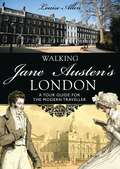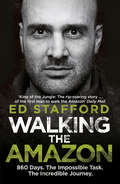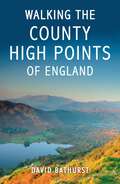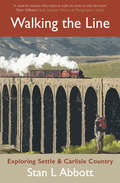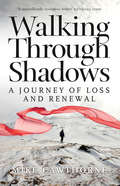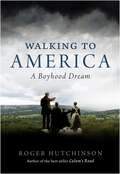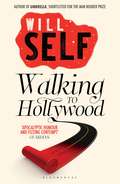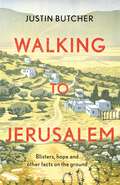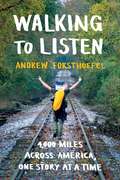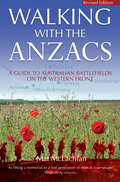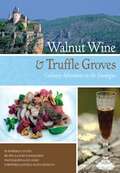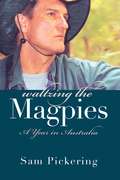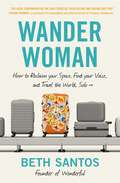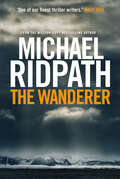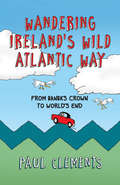- Table View
- List View
Walking Jane Austen’s London
by Louise AllenFrom prize-winning historical novelist Louise Allen, this book presents nine walks through both the London Jane Austen knew and the London of her novels! Follow in Jane's footsteps to her publisher's doorstep and the Prince Regent's vanished palace, see where she stayed when she was correcting proofs of Sense and Sensibility and accompany her on a shopping expedition – and afterwards to the theatre. In modern London the walker can still visit the church where Lydia Bennett married Wickham, stroll with Elinor Dashwood in Kensington Palace Gardens or imagine they follow Jane's naval officer brothers as they stride down Whitehall to the Admiralty. From well-known landmarks to hidden corners, these walks reveal a lost London that can still come alive in vivid detail for the curious visitor, who will discover eighteenth-century chop houses, elegant squares, sinister prisons, bustling city streets and exclusive gentlemen's clubs amongst innumerable other Austen-esque delights.
Walking the Amazon: 860 Days. The Impossible Task. The Incredible Journey
by Ed StaffordIn April 2008, Ed Stafford began his attempt to become the first man ever to walk the entire length of the River Amazon. Nearly two and a half years later, he had crossed the whole of South America to reach the mouth of the colossal river.With danger a constant companion - outwitting alligators, jaguars, pit vipers and electric eels, not to mention overcoming the hurdles of injuries and relentless tropical storms - Ed's journey demanded extreme physical and mental strength. Often warned by natives that he would die, Ed even found himself pursued by machete-wielding tribesmen and detained for murder.However, Ed's journey was an adventure with a purpose: to help raise people's awareness of environmental issues. Ed had unprecedented access to indigenous communities and witnessed the devastating effects of the deforestation of the Amazon rainforest first-hand. His story of disappearing tribes and loss of habitats concerns us all.Ultimately though, Walking the Amazon is an account of a world-first expedition that takes readers on the most daring journey along the world's greatest river and through the most bio-diverse habitat on earth.
Walking the Americas: ‘A wildly entertaining account of his epic journey’ Daily Mail
by Levison WoodLONGLISTED IN THE ADVENTURE TRAVEL CATEGORY OF THE 2017 BANFF MOUNTAIN BOOK AWARDS SUNDAY TIMES TOP 10 BESTSELLERBY THE AUTHOR OF WALKING THE HIMALAYAS, WINNER OF THE 2016 EDWARD STANFORD ADVENTURE TRAVEL BOOK OF THE YEAR AWARD'Levison Wood has breathed new life into adventure travel.' Michael PalinWalking the Americas chronicles Levison Wood's 1,800 mile trek along the spine of the Americas, through eight countries, from Mexico to Colombia, experiencing some of the world's most diverse, beautiful and unpredictable places.His journey took him from violent and dangerous cities to ancient Mayan ruins lying still unexplored in the jungles of Mexico and Guatemala. He encountered members of indigenous tribes, migrants heading towards the US border and proud Nicaraguan revolutionaries on his travels, where at the end of it all, he attempted to cross one of the most impenetrable borders on earth: the Darien Gap route from Panama into South America.This trek required every ounce of Levison Wood's guile, tact, strength and resilience in one of the most raw, real and exciting journeys of his life.
Walking the Bones of Britain: A 3 Billion Year Journey from the Outer Hebrides to the Thames Estuary
by Christopher Somerville‘Somerville’s infectious enthusiasm and wry humour infuse his journey from the Isle of Lewis to southern England, revealing our rich geological history with vibrant local and natural history’ Observer‘A meticulous exploration of the ground beneath our feet. Glorious’ Katharine Norbury‘A remarkable achievement’ Tom Chesshyre‘His writing is utterly enticing’ Country Walking...............................................................................................................................................The influence Britain’s geology has had on our daily lives is profound. While we may be unaware of it, every aspect of our history has been affected by events that happened ten thousand, a million, or a thousand million years ago.In Walking the Bones of Britain, Christopher Somerville takes a journey of a thousand miles, beginning in the far north, at the three-billion-year-old rocks of the Isle of Lewis, formed when the world was still molten, and travelling south-eastwards to the furthest corner of Essex, where new land is being formed. Crossing bogs, scaling peaks and skirting quarry pits, he unearths the stories bound up in the layers of rock beneath our feet, and examines how they have influenced everything from how we farm to how we build our houses, from the Industrial Revolution to the current climate crisis.Told with characteristic humour and insight, this gripping exploration of the British landscape and its remarkable history cannot fail to change the way you see the world beyond your door.‘Somerville is a walker’s writer’ Nicholas Crane
Walking the County High Points of England
by David BathurstAn indefatigable walker, David Bathurst has unlaced his boots to produce this unique companion to the country’s most rewarding hilltop trails, from the Pennine Way to the misty Malverns. His appreciation of the beauty and history of the British countryside and his light-hearted style will appeal to experienced and novice walkers alike.
Walking the Great North Line: From Stonehenge to Lindisfarne to Discover the Mysteries of Our Ancient Past
by Robert TwiggerRobert Twigger, poet and travel author, was in search of a new way up England when he stumbled across the Great North Line. From Christchurch on the South Coast to Old Sarum to Stonehenge, to Avebury, to Notgrove barrow, to Meon Hill in the midlands, to Thor's Cave, to Arbor Low stone circle, to Mam Tor, to Ilkley in Yorkshire and its three stone circles and the Swastika Stone, to several forts and camps in Northumberland to Lindisfarne (plus about thirty more sites en route). A single dead straight line following 1 degree 50 West up Britain. No other north-south straight line goes through so many ancient sites of such significance. Was it just a suggestive coincidence or were they built intentionally? Twigger walks the line, which takes him through Birmingham, Halifax and Consett as well as Salisbury Plain, the Peak district, and the Yorkshire moors. With a planning schedule that focused more on reading about shamanism and beat poetry than hardening his feet up, he sets off ever hopeful. He wild-camps along the way, living like a homeless bum, with a heart that starts stifled but ends up soaring with the beauty of life. He sleeps in a prehistoric cave, falls into a river, crosses a 'suicide viaduct' and gets told off by a farmer's wife for trespassing; but in this simple life he finds woven gold. He walks with others and he walks alone, ever alert to the incongruities of the edgelands he is journeying through.
Walking the Himalayas: An adventure of survival and endurance
by Levison WoodWINNER OF THE 2016 EDWARD STANFORD ADVENTURE TRAVEL BOOK OF THE YEAR AWARD'Levison Wood has breathed new life into adventure travel.' Michael Palin'Levison Wood is a great adventurer and a wonderful storyteller.' Sir Ranulph Fiennes'Britain's best-loved adventurer... he looks like a man who will stare danger in the face and soak up a lot of pain without complaint.' The TimesFollowing in in the footsteps of the great explorers, WALKING THE HIMALAYAS is Levison Wood's enthralling account of crossing the Himalayas on foot. His journey of discovery along the path of the ancient trade route of the Silk Road to the forgotten kingdom of Bhutan led him beyond the safety of the tourist trail. There lies the real world of the Himalayas, where ex-paratrooper Levison Wood encountered natural disasters, extremists, nomadic goat herders, shamans (and the Dalai Lama) in his 1,700-mile trek across the roof of the world. WALKING THE HIMALAYAS is a tale of courage, stamina and the kindness of strangers that will appeal to the adventurer in us all.
Walking the Line: Exploring Settle & Carlisle Country
by Stan AbbottWidely known as England’s most scenic line, the enduring Settle & Carlisle Railway was built by the Midland between 1869 and 1876, as part of its quest to forge its own, independent route to Scotland. It is, uniquely for a railway in the UK, a Conservation Area in its own right – viaducts, tunnels, bridges, stations, trackside structures and railway workers’ cottages. By walking all or parts of the route from Settle to Carlisle, you get the chance to get up close to the railway’s magnificent architecture – but also to see the lonely and lofty fells, and stunning scenery from the Dales through the Pennines to the limestone pavements of Westmorland and the green Eden Valley. In the company of this knowledgeable guide, you’ll also discover centuries’-worth of local history and traditions: Roman remains, medieval castles, and the Romany who still meet at the annual Appleby Horse Fair gathering.
Walking the Woods and the Water: In Patrick Leigh Fermor's Footsteps from the Hook of Holland to the Golden Horn
by Nick HuntIn 1933, the eighteen year old Patrick Leigh Fermor set out in a pair of hobnailed boots to chance and charm his way across Europe, like a tramp, a pilgrim or a wandering scholar. The books he later wrote about this walk, A Time of Gifts, Between the Woods and the Water, and the posthumous The Broken Road are a half-remembered, half-reimagined journey through cultures now extinct, landscapes irrevocably altered by the traumas of the twentieth century. Aged eighteen, Nick Hunt read A Time of Gifts and dreamed of following in Fermor's footsteps.In 2011 he began his own great trudge - on foot all the way to Istanbul. He walked across Europe through eight countries, following two major rivers and crossing three mountain ranges. Using Fermor's books as his only travel guide, he trekked some 2,500 miles through Holland, Germany, Austria, Slovakia, Hungary, Romania, Bulgaria and Turkey. His aim? To have an old-fashioned adventure. To slow down and linger in a world where we pass by so much, so fast. To discover for himself what remained of hospitality, kindness to strangers, freedom, wildness, adventure, the mysterious, the unknown, the deeper currents of myth and story that still flow beneath Europe's surface.
Walking Through Shadows: A Journey of Loss and Renewal
by Mike CawthorneWalking Through Shadows describes a winter walk in memory of the author’s friend, Clive Dennier, a popular Inverness journalist, who died in Knoydart in March 2013 but whose body was found only some weeks later. The journey begins at Whiten Head on the north Sutherland coast and ends at Kinloch Hourn in Knoydart, the place where Clive was eventually found. Mike Cawthorne undertook the walk with his friend, Nick (also a friend of Clive’s), from mid-January to late February 2015. Their walk traversed the wildest and most remote areas of Britain, often in atrocious winter conditions. The walkers were entirely reliant on food parcels buried beforehand.As well as describing some the last wild places in Scotland in the heart of winter the narrative explores themes of grief, chance, mental illness and ecological damage. The author’s companion is struggling throughout with the effects of severe mental illness but sees in the walk the hope of some relief from this suffering. The walkers are asking a question: whether the hills can heal at a human level and whether the hills can themselves be healed. In the shadow of the Anthropocene Mike Cawthorne evokes the darkness of winter, of two individuals seeking answers, alone in a freezing wilderness that is both beautiful and moribund. In the context of an extreme mountaineering adventure, he is grappling with issues of vital importance to us all.
Walking to America: A Boyhood Dream
by Roger Hutchinson"Walking To America" follows and recreates the immense journey, in search of a new life and of a miracle doctor who could cure the blindness of one of their number. The journey was taken largely on foot by a small working-class family unit from England in the 1880s, to Liverpool, Philadelphia, Pittsburgh, New Orleans, Texas, New Mexico, Arizona and back again. Written as travelogue and as a history of one of the great neglected subjects - the New World immigrants who returned home to the Old, "Walking to America" is a personal tale, full of characterisation and human stories, based upon received lore, followed footsteps and careful historical research.An epic, covering thousands of miles and cultures and environments as diverse as the Victorian UK coalfields, the great imperial entrepot of Liverpool, the post-bellum American south, roaring 1880s New Orleans, the stew of the free-for-all Pittsburgh mines, Texas in the wake of the Alamo, the unclaimed Indian Territory of North America and the ultimate frontier of the Petrified Forest in Arizona - all seen through the eyes of a small group of identifiable and sympathetic, real and ordinary men, women and children from the north-east of England. "Walking to America" is a great and gripping adventure of discovery, hope and loss. And it is all true.
Walking to Hollywood: Memories Of Before The Fall
by Will SelfWalking to Hollywood is a dazzling triptych - obsessive, satirical, elegiac - in which Will Self burrows down through the intersections of time, place and psyche to explore some of our deepest fears and anxieties with characteristic fearlessness and jagged humour.'Very Little' is ostensibly the account of a curative journey to Canada and the USA, but in fact the record of a nematode's progress, as the worm of obsession - with scale and packing and the 'stuff' of our lives - bores through a mind in extremesis. 'Walking to Hollywood' is an extreme satire on celebrity, in which the narrator believes that everyone he meets is played by a famous actor, and that only he can solve the mystery of who murdered the movies. 'Spurn Head' leads Self to a tormented sojourn with a madman whose house is sliding over the edge of a cliff, to a game of checkers with Death, and finally to an encounter with one of Swift's immortal Struldbruggs and a march through a tear in time itself. In Walking to Hollywood Will Self pushes memoir to the limits of invention.
Walking to Jerusalem: Blisters, hope and other facts on the ground
by Justin Butcher2017 marked three important anniversaries for the Palestinian people: 100 years since the Balfour Declaration; 50 years since the Six-day War; and ten years since the Blockade of Gaza. As an act of penance, solidarity and hope, actor and musician Justin Butcher - along with ten other companions for the full route, plus another hundred joining him for various stretches along the way - walked from London to Jerusalem. This book is the record of his journey: a combination of walking journal, travel writing and pilgrim stories. It's less of a travel guide to walking across Europe and more an exploration of the many strands radiating from the Holy Land and its narrative, weaving paths across place and history, through the lives of Justin's fellow-walkers - and, of course, his own life. Between the route itinerary and the themes of Balfour and Christian Zionism, Weizmann and cordite, colonialism, Jerusalem Syndrome and Desert spirituality, Justin charts a chronicle of serendipity: happenstances hilarious, infuriating and occasionally numinous - or, as pilgrims might say, encounters with the Divine.
Walking to Listen: 4,000 Miles Across America, One Story at a Time
by Andrew ForsthoefelA memoir of one young man's coming of age on a journey across America--told through the stories of the people of all ages, races, and inclinations he meets along the way. Life is fast, and I've found it's easy to confuse the miraculous for the mundane, so I'm slowing down, way down, in order to give my full presence to the extraordinary that infuses each moment and resides in every one of us. At 23, Andrew Forsthoefel headed out the back door of his home in Chadds Ford, Pennsylvania, with a backpack, an audio recorder, his copies of Whitman and Rilke, and a sign that read "Walking to Listen." He had just graduated from Middlebury College and was ready to begin his adult life, but he didn't know how. So he decided to take a cross-country quest for guidance, one where everyone he met would be his guide. In the year that followed, he faced an Appalachian winter and a Mojave summer. He met beasts inside: fear, loneliness, doubt. But he also encountered incredible kindness from strangers. Thousands shared their stories with him, sometimes confiding their prejudices, too. Often he didn't know how to respond. How to find unity in diversity? How to stay connected, even as fear works to tear us apart? He listened for answers to these questions, and to the existential questions every human must face, and began to find that the answer might be in listening itself. Ultimately, it's the stories of others living all along the roads of America that carry this journey and sing out in a hopeful, heartfelt book about how a life is made, and how our nation defines itself on the most human level.
Walking With Cattle: In Search of the Last Drovers of Uist
by Terry J. WilliamsDroving was once the lifeblood of Scotland's rural economy, and for centuries Scotland's glens and mountain passes were alive with thousands of cattle making their way to the market trysts of Crieff and Falkirk. With the Industrial Revolution, ships, railways and eventually lorries took over the drovers' trade, and by the early twentieth century, the age-old droving tradition was all but dead. Except, however, in the Western Isles, where droving on foot continued until the mid-1960s, when MacBrayne's introduced a new generation of ferries capable of bringing livestock lorries to the islands.In Walking with Cattle, Terry J. Williams follows the route of the drovers and their cattle from Outer Hebrides to the Highland marts. Travelling by campervan and armed with a voice recorder, a collection of archive photographs and a set of maps marked with the old market stances, she seeks out the last surviving drovers. The resulting narrative is an extraordinary insight into a lost world, told through the voices of the few remaining individuals who remember the days of walking with cattle.
Walking with the ANZACS: The authoritative guide to the Australian battlefields of the Western Front
by Mat McLachlan'[Mat McLachlan's] knowledge of the front is comprehensive' - Sydney Morning HeraldA complete guide to the Australian battlefields of the Western Front 1916-18.Walking with the ANZACs aims to become the new essential companion for Australians visiting the Western Front. Each of the 14 most important Australian battlefields is covered with descriptions of the battles and Australia’s involvement in it.The book presents a well-illustrated walking tour across the old battlefields. The tours are designed along easily accessible walking routes and show readers battlefield landmarks that still exist, memorials to the men who fought there and the cemeteries where many of them still lie. In this way the visitor will see the battlefield in much the same way as the original ANZACs did, and gain a greater appreciation of the site’s significance. Importantly, the tours are not written for military experts, but for ordinary visitors whose military knowledge may be limited.More than just a handy travel guide, Walking with the ANZACs is an absorbing read for armchair travellers and students of the First World War who may not have had the opportunity to visit the battle fields and walk in the footsteps of the first ANZACs.
Walks on the Wild Side: Exploring an Unforgiving Land
by John PakenhamEXPLORING AN UNFORGIVING LANDIn the early 1980s, John Pakenham walked a total of 1,200 miles through the volcanic desert around Lake Turkana in northern Kenya in the company of local Turkana and Samburu tribesmen and their long-suffering donkeys.Repeatedly beset by extreme thirst and dehydration, blistering heat, bitterly cold torrential rains, poisonous spiders, vindictive mosquitoes and the ever-present threat of bandits, not to mention a fatal fight between two of his companions, he was lucky to live to tell his tale.Pakenham’s account provides a rare glimpse of a tough terrain and its even tougher inhabitants, where every day was a battle for survival. This is extreme travel that, four decades on, still packs a powerful punch.
Wall Memorials and Heritage: The Heritage Industry of Berlin's Checkpoint Charlie
by Sybille FrankAnalysing the transformation of Berlin’s former Allied border control point, "Checkpoint Charlie," into a global heritage industry, this volume provides an introduction to, and a theoretically informed structuring of, the interdisciplinary international heritage debate. This crucial case study demonstrates that an unregulated global heritage industry has developed in Berlin which capitalizes on the internationally very attractive – but locally still very painful – heritage of the Berlin Wall. Frank explores the conflicts that occur when private, commercial interests in interpreting and selling history to an international audience clash with traditional, institutionalized public forms of local and national heritage-making and commemorative practices, and with the victims’ perspectives. Wall Memorials and Heritage illustrates existing approaches to heritage research and develops them in dialogue with Berlin’s traditions of conveying history, and the specific configuration of the heritage industry at "Checkpoint Charlie". Productively integrating theory with empirical evidence, this innovative book enriches the international literature on heritage and its economic and political contexts.
Wall Memorials and Heritage: The Heritage Industry of Berlin's Checkpoint Charlie
by Sybille FrankAnalysing the transformation of Berlin’s former Allied border control point, "Checkpoint Charlie," into a global heritage industry, this volume provides an introduction to, and a theoretically informed structuring of, the interdisciplinary international heritage debate. This crucial case study demonstrates that an unregulated global heritage industry has developed in Berlin which capitalizes on the internationally very attractive – but locally still very painful – heritage of the Berlin Wall. Frank explores the conflicts that occur when private, commercial interests in interpreting and selling history to an international audience clash with traditional, institutionalized public forms of local and national heritage-making and commemorative practices, and with the victims’ perspectives. Wall Memorials and Heritage illustrates existing approaches to heritage research and develops them in dialogue with Berlin’s traditions of conveying history, and the specific configuration of the heritage industry at "Checkpoint Charlie". Productively integrating theory with empirical evidence, this innovative book enriches the international literature on heritage and its economic and political contexts.
Walnut Wine and Truffle Groves: Culinary Adventures in the Dordogne
by Kimberley Lovato Laura SchmalhorstPull up a chair and visit the Dordogne (called Périgord by the locals) the way it should be visited: one bite at a time. Walnut Wine and Truffle Groves is a culinary travel book that navigates the back roads—as well as the menus and markets—of the southwestern region of France with newfound excitement. Through interviews with local home cooks and chefs, visits to local farms, historic sites and wineries, market tours, and serendipitous detours, Lovato provides a glimpse into this unspoiled wonderland. The alluring recipes and stunning photographs let readers discover the true jewels in France&’s culinary crown as well as discover the country&’s most beautiful and less trod-upon provinces. Winner of the 2010 Gourmand World Cookbooks Award (USA) for Culinary Travel in the category of Lifestyle, Body and Soul and a Cordon d' Or - Gold Ribbon International Culinary Academy Award in 2011.
Waltzing the Magpies: A Year in Australia
by Sam PickeringPraise for Sam Pickering: "The art of the essay as delivered by Mr. Pickering is the art of the front porch ramble." ---The New York Times Book Review "Reading Pickering . . . is like taking a walk with your oldest, wittiest friend." ---Smithsonian "What a joy it is to 'mess around' with Professor Sam Pickering!" ---The Chattanooga Times "Pickering is a barefoot observer of the quotidian who revels in the spectacle and its gift for surprise, prefers the rumpled to the starched, has raised puttering and messing about to an art form, and wrings from it more than a pennyworth of happiness and a life well lived." ---Kirkus Reviews The movie Dead Poets Society is where most Americans first met Sam Pickering, the University of Connecticut English professor. Robin Williams plays the lead character (loosely based on Pickering), an idiosyncratic instructor who employs some over-the-top teaching methods to keep his subjects fresh and his students learning. Fewer know that Pickering is the author of more than 16 books and nearly 200 articles, or that he's inspired thousands of university students to think in new ways. And, while Williams may have captured Pickering's madcap classroom antics, he didn't uncover the other side of the author-Sam Pickering as one of our great American men of letters. Like the music of Mozart, the painting of Picasso, or the poetry of Emily Dickinson, you can spot Pickering's writing a mile away; there's no mistaking the Pickering pen. As an ample demonstration of the author's literary gifts, Waltzing the Magpies is his unabashedly lush and Technicolor travelogue from Down Under. On the face of it, Waltzing is the chronicle of a sabbatical year spent with family in Australia. Yet beneath the surface Pickering's big themes-family, nature, seizing the moment-move in a powerful current that frequently bursts out in moments of ecstatic revelation and intense sensual flourish. Through it all Pickering weaves stories from his fictional Southern town of Carthage, Tennessee, especially when the goings of the outside world get rough. Waltzing the Magpies is classic Pickering at the height of his literary powers, and places him in the company of such great American essayists as E. B. White and James Thurber, but with an irony and observational prowess that is pure Pickering.
Wander Woman: How to Reclaim Your Space, Find Your Voice, and Travel the World, Solo
by Beth Santos&“The ideal companion for the solo traveler, both before and during her trip.&” — Pauline Frommer Achieve your solo female travel dreams with this empowering guide for women who want to see the world—perfect for anyone who has felt the tug of wanderlust after reading Wild, Eat Pray Love, or What I Was Doing While You Were Breeding. If you&’ve ever wanted to travel solo, founder of global women&’s travel community Wanderful, Beth Santos, is here to tell you that you&’re not alone. Travel isn&’t just about how many passport stamps you have—it&’s about your mindset. In Wander Woman, Santos busts myths about who can travel, empowering women to uncover the confidence they need to see the world for themselves, by themselves, and giving them the lifelong tools to challenge your preconceptions, try something new, and get out of your comfort zone—whether that&’s halfway around the world or just down the street. Readers will also learn… A new rubric for personal safety that pushes back on traditional ideas of what&’s &“safe&” for women. How to eat alone (and not have to make awkward small talk with the waiter). Why a &“Day Zero&” will revolutionize your itinerary. Where to find community and a new perspective on what &“counts&” as solo travel How to travel ethically, sustainably, and in budget. As much a how-to guide as it is a source of inspiration and support, Wander Woman invites us to be mindful about why we travel, who it affects, and how we can make it better for everyone. Whether you&’re ready to chase your Under the Tuscan Sun fantasy, are preparing for study abroad, or just want to feel more comfortable on business trips, Wander Woman is your must-have guide to exploring the world without fear.
The Wanderer: A fantastic international thriller for fans of Peter James (A Magnus Iceland Mystery)
by Michael RidpathFrom the million-copy bestselling author, perfect for fans of Stieg Larsson, Anne Holt, and The Killing.'Michael Ridpath is trouncing the Scandinavians on their home turf. This is international thriller writing at its best.' Peter JamesIceland, 2017: When a young Italian tourist is found brutally murdered at a sacred church in northern Iceland, Magnus Jonson, newly returned to the Reykjavík police force, is called in to investigate. At the scene, he finds a stunned TV crew, there to film a documentary on the life of the legendary Viking, Gudrid the Wanderer. Magnus quickly begins to suspect that there may be more links to the murdered woman than anyone in the film crew will acknowledge. As jealousies come to the surface, new tensions replace old friendships, and history begins to rewrite itself, a shocking second murder leads Magnus to question everything he thought he knew...
Wandering Ireland's Wild Atlantic Way: From Banba's Crown To World's End
by Paul ClementsFollowing the spirit of the world’s longest coastal driving route, Paul Clements sets out to discover the real west of Ireland. Along the way he encounters memorable characters living on the Atlantic edge and presents a unique portrait of their lives. We meet the last man standing on a remote Galway island, listen to the banter at Puck Fair, and hear from a descendant of the original sixteenth-century wild Atlantic woman. Tagging along on his meandering journey is the swashbuckling presence of the Celtic sea god, Manannán Mac Lir. For his first travel book in 1991, Paul hitchhiked the same route. Now retracing his steps along the Wild Atlantic Way – this time by car and bike, on horseback and on foot – he looks at how Ireland has changed and realises everyone still has a story to tell. Laced with wry humour and endless curiosity, this is a distinctive mix of travel writing, social history and nature. Also by this author: ‘The Height of Nonsense: The Ultimate Irish Road Trip’ Praise for this author: “Stacks of free copies should be sent to all our tourist desks abroad.” – The Irish Times. “For sheer pleasure, nothing I read beat Paul Clements’ ‘The Height of Nonsense’.” – The Observer. “A compulsive, educational, laugh-out-loud read.” – Sunday Independent. "A fascinating journey around the hidden corners of Ireland." – BBC Radio
The Wandering Lake: Into the Heart of Asia
by Sven HedinThe lake of Lop Nur, the 'heart of the heart of Asia', is one of the world's strangest phenomena. Situated in the wild Chinese province of Xinjiang, Lop Nur - 'the wandering lake'- has for millennia been in a perpetual state of flux, drifting north to south, often tens of kilometres in as many years. It was once the lifeblood of the great Silk Road kingdom of Loulan, which flourished in this otherwise barren region 2,000 years ago and its peculiar movements confused even Ptolemy, who marked the lake twice on his map of Asia. Following 'the pulse-beats of Lop Nur as a doctor examines a patient's heart', Sven Hedin became captivated by its peripatetic movements and for forty years his destiny was inextricably linked with that of this mysterious lake and the region surrounding it. His last journey to Lop Nur was in 1934, just days after he was released as a prisoner of General Ma Chung-yin (the rebel leader of Xinjiang). Travelling the length of the Konche-daria and Kum-daria rivers by canoe, Hedin embarked on his last Central Asian expedition and proved what he had always suspected - that Lop Nur did indeed shift position - and why. When he camped on its vast banks at night, Lop Nur was deep and full. Today, this once great lake - a a mighty reservoir in the desert - is nothing but windblown sand and salty marsh. The third in Sven Hedin's Central Asia trilogy, The Wandering Lake is arguably his most famous work. It is, typically, a gripping story of adventure and discovery but it is also a rare account of a now-vanished world; a masterpiece by one of history's last great explorers.
